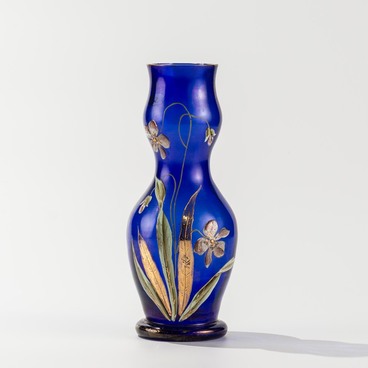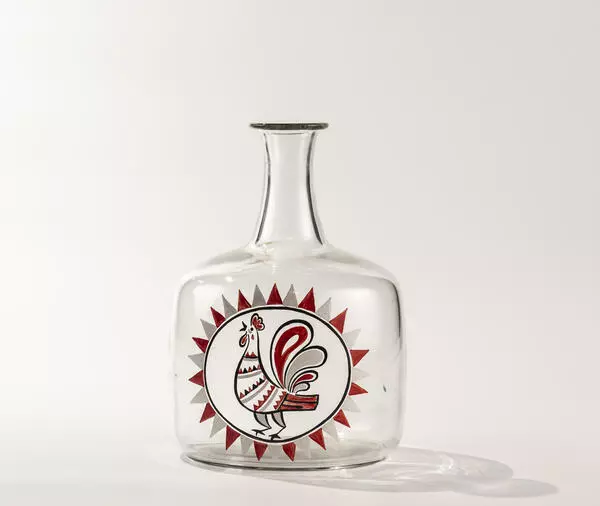A decanter is a vessel that is used for serving drinks. The Russian name “grafin” comes from the English word “carafe”. Glass decanters first appeared in England between 1725 and 1750. They were designed based on bottles, had a glass stopper, were intended for serving drinks to two people, and were placed on the table between them. Initially, this vessel was known in Russia as a “carafin”: this is how it was first mentioned in the notes of Peter the Great. This is also what it was called in Pushkin’s notes during his time as a lyceum student. In his later poem “Count Nulin”, however, Pushkin mentioned the vessel under its modern name.
The decanter from the museum collection is one of the elements of the decorative composition “Polyushko-pole” which can be translated as “Oh Fields, My Fields”. It also included four decorative glasses of various sizes. The composition was designed by Svetlana Ryazanova, one of the numerous graduates of the Moscow School of Decorative and Applied Art who put their ideas into practice at the Dyatkovo Crystal Factory.
They arrived at the factory in the 1960s, with the motto of this period being “Art into Every House!” It meant that artists were supposed to design simple, easy-to-manufacture objects for mass and large-scale production, mainly made of smooth glass. They also reinterpreted the traditional method of decorating glass products with painting, and the elements of patterns were integrated into the general decoration concept, taking into consideration the volume and the transparency of glass items. An example of such floral and plot-driven painting is the “Polyushko-pole” composition.
The decanter is the main element of the composition. It was created using the blowing technique. The method of blowing glass products with a pipe has remained unchanged for many centuries. The glass is blown at a temperature of around 1000 ºС. The decanter from the “Polyushko-pole” composition is made of smoky glass. Such glass is obtained by mixing three colorants: nickel, cobalt, and chromium. Smoky glass may be either gray or colored with a certain dominant shade. Gray glass offers uniform transmission of all colors in the daylight spectrum. Using gray glass as the basis, artists can achieve any shade by varying the ratio of colorants. The melting of such glass does not depend on such factors as temperature or oxidation-reduction reactions.
The decanter from the museum collection is one of the elements of the decorative composition “Polyushko-pole” which can be translated as “Oh Fields, My Fields”. It also included four decorative glasses of various sizes. The composition was designed by Svetlana Ryazanova, one of the numerous graduates of the Moscow School of Decorative and Applied Art who put their ideas into practice at the Dyatkovo Crystal Factory.
They arrived at the factory in the 1960s, with the motto of this period being “Art into Every House!” It meant that artists were supposed to design simple, easy-to-manufacture objects for mass and large-scale production, mainly made of smooth glass. They also reinterpreted the traditional method of decorating glass products with painting, and the elements of patterns were integrated into the general decoration concept, taking into consideration the volume and the transparency of glass items. An example of such floral and plot-driven painting is the “Polyushko-pole” composition.
The decanter is the main element of the composition. It was created using the blowing technique. The method of blowing glass products with a pipe has remained unchanged for many centuries. The glass is blown at a temperature of around 1000 ºС. The decanter from the “Polyushko-pole” composition is made of smoky glass. Such glass is obtained by mixing three colorants: nickel, cobalt, and chromium. Smoky glass may be either gray or colored with a certain dominant shade. Gray glass offers uniform transmission of all colors in the daylight spectrum. Using gray glass as the basis, artists can achieve any shade by varying the ratio of colorants. The melting of such glass does not depend on such factors as temperature or oxidation-reduction reactions.



